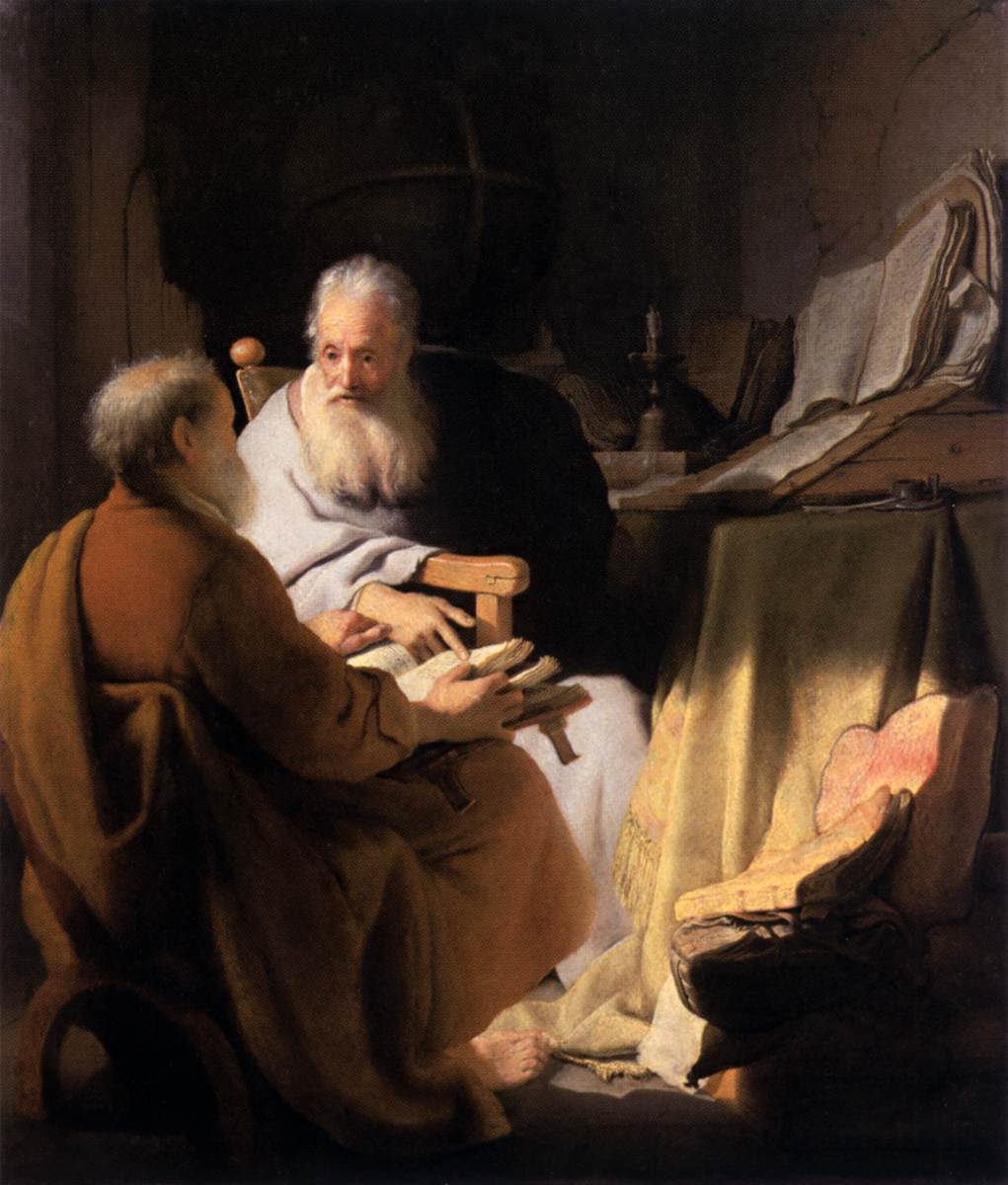* * * *
* * * *
For starters, today, a change of pace question: “Is God is man or woman?” Should we address Him – anthropomorphism – as Father (Abba) or Mother? In my view, “He” is both. God is the Ultimate Married Couple. (No autocratic Pater familias.) We humans – men and women, alone – are only “half” of what we could and should be. That explains the “we” in passages like and Genesis 1:26 and Genesis 11:7, and why men and women spend so much time and effort trying to get together. (Illustrated in part by Salome‘s ability to beguile her father.)
Well, that and the hormones…
* * * *
Back to a main theme of the blog. We have two major feast days at the end of June. Saturday, June 24, was the feast remembering the Birth of St. John, the Baptist. Next Thursday, June 29, is the day for remembering St. Peter and St. Paul, Apostles. Thus the “et alia” in the title, meaning “and others,” and those others are Saints Peter and Paul.
The 2015 post Nativity of John the Baptist noted that John was the prophet who “foretold the coming of the Messiah in the person of Jesus, whom he later baptised.” Luke 1:57-80 tells of Elizabeth – cousin of Mary (mother of Jesus) – becoming a mother, late in life, and how her husband got struck dumb. (Elizabeth had been barren, and she and her husband were old).
The time came for Elizabeth to give birth, and she bore a son. Her neighbors and relatives heard that the Lord had shown his great mercy to her, and they rejoiced… [T]hey were going to name him Zechariah after his father. But his mother said, “No; he is to be called John.” They said to her, “None of your relatives has this name.” Then they began motioning to his father to find out what name he wanted to give him. He asked for a writing tablet and wrote, “His name is John…”
John grew up to serve as forerunner or advance man for Jesus. (As in, “News Flash: Jesus is on the way!“) As it says in the Collect: “your servant John the Baptist … sent to prepare the way of your Son our Savior.” But there was a downside to the job. That’s where Salome came in:
[T]hat “advance work for Jesus” included a gruesome death by beheading, as told in Mark 6:14–29: “the king sent a soldier of the guard with orders to bring John’s head. He went and beheaded him in the prison, brought his head on a platter, and gave it to [Salome]… When his disciples heard about it, they came and took his body, and laid it in a tomb.”
There’s more detail in the “Nativity 2015” post, but you get the idea.
The post John the Baptist, Peter and Paul – 2016 noted each year on January 18 we celebrate the Confession of Peter: “Thou art the Christ, Son of the Living God.” A week later on January 25 we celebrate the Conversion of St. Paul. Then comes June 29, when we celebrate both saints, together. And mostly to remember the “translation of their relics:”
On 29 June we commemorate the martyrdoms of both apostles. The date is the anniversary of a day around 258, under the Valerian Persecution, when what were believed to be the remains of the two apostles were both moved temporarily to prevent them from falling into the hands of the persecutors.
Here the term relic means the body parts of people considered holy. (Like Peter and Paul.) Translating relics means moving those holy objects from one locale to another. (Usually to a “better neighborhood,” metaphorically or otherwise.) As for their deaths, the Bible gives no detail. But early tradition said they were martyred at Rome, at the command of the Emperor:
As a Roman citizen, Paul would probably have been beheaded with a sword. It is said of Peter that he was crucified head downward[. And thus as St. Augustine wrote,] “even though they suffered on different days, they were as one. Peter went first, and Paul followed. And so we celebrate this day made holy for us by the apostles’ blood…”
Another point to remember: It’s okay for Christians to have different opinions. (No human being is infallible.) Even saints like Peter and Paul disputed, including the Incident at Antioch. Of the dispute Wikipedia said the outcome remains uncertain, “resulting in several Christian views of the Old Covenant to this day.” (That dispute involved how much of the Old Testament law was binding on new, non-Jewish Christians. Like whether new, non-Jewish male Christians had to get circumcised.) That process of dispute resolution – called dialectics – is how we make spiritual progress, working together. That’s called the adversary system in our country.
Since the Fourth of July is coming right up, how much more American can you get?
So go ahead. Argue and dispute away. Just try not to tell anyone who dares disagree with you that “you’re going to hell.” (Remembering Deuteronomy 19:16, “et sequitur.”)
* * * *

* * * *
The upper image is courtesy of Salome – Wikipedia. The caption: “‘Salomé,’ by Henri Regnault (1870).” The article added that this Salome (III) was…
…a Jewish princess, the daughter of Herod II, who was the son of Herod the Great, with princess Herodias. She was granddaughter of Herod the Great, and stepdaughter of Herod Antipas. She is known from the New Testament, where she is not named, and from an account by Flavius Josephus. In the New Testament, the stepdaughter of Herod Antipas demands and receives the head of John the Baptist.
The Book of Common Prayer reference. The “corporate-mystical” prayer is on page 339, the post-communion prayer for Holy Eucharist, Rite I.
Re: God as man or woman. Google “is god man or woman,” or see Is God a Man, Woman or Neither? – Bible Study: “Since God is composed of spirit (John 4:24), he is not male or female, masculine or feminine… Yet, in scripture, the Eternal constantly refers to Himself as a ‘He, not as an ‘it’ or as a ‘she.’ This truth makes some feminists not happy.” That’s an Old School answer, but my take on the question solves that problem. Or see Gender of God – Wikipedia, “Classical western philosophy believes that God lacks a literal sex as it would be impossible for God to have a body:”
In the Hebrew and Christian Bible, God is usually described in male terms in biblical sources, with female analogy in Genesis 1:26-27, Psalm 123:2-3, and Luke 15:8-10; a mother in Deuteronomy 32:18, Isaiah 66:13, Isaiah 49:15, Isaiah 42:14, Psalm 131:2; and a mother hen in Matthew 23:37 and Luke 13:34, although never directly referred to as being female.
Also, “In Mormonism, God the Father is male and is married to the female Heavenly Mother.”
On these two feast days see also On “John T. Baptist,” Peter and Paul – 2021.
The lower image is courtesy of Two Scholars Disputing by REMBRANDT Harmenszoon … (web gallery of art.) The explanatory section added that the most likely explanation of the painting is that it “represents St Peter and St Paul in conversation,” or even Argument:
Rembrandt omits the attributes by which the two apostles were traditionally identified, he relies only on their physical characteristics … and on what they are seen to be doing, that is earnestly discussing a text which the one (St Peter) is explaining to the other.
For other interpretations and/or images, see also www.canvasreplicas.com/Rembrandt.htm. See also Two Scholars Disputing by REMBRANDT Harmenszoon van Rijn.
* * * *
